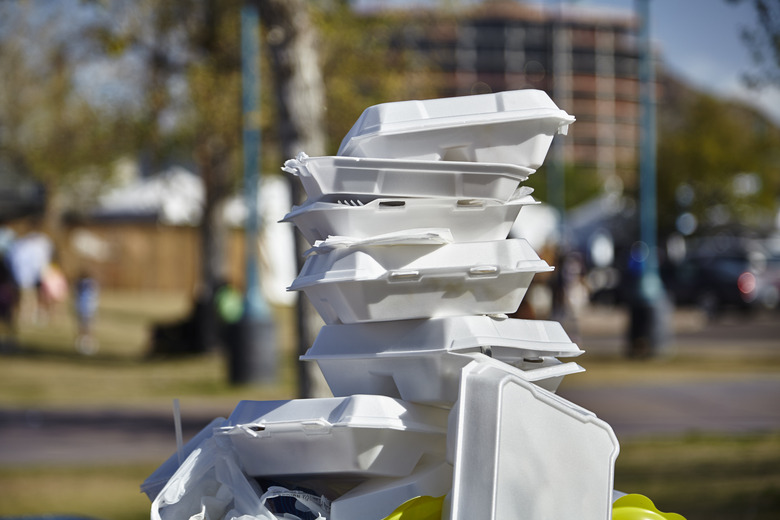What Are The Dangers Of Accidentally Burning Styrofoam?
Burning Styrofoam, or polystyrene, is the least appropriate way to get rid of it for both people and the environment. Research has shown that when Styrofoam is burned it releases toxic chemicals and smoke that can damage the nervous system and lungs. These chemicals need to be ingested in large amounts or over a period of time to show significant damage, so burning a small amount of Styrofoam accidentally won't harm you or the environment significantly. When Styrofoam is safely burned as a method to dispose if it, it is burned in a controlled environment at extremely high temperatures. Campfire or trash burning temperatures will not burn hot enough to keep toxic chemicals from forming and toxins to be released.
Styrene
Styrene
Styrene is the most worrisome chemical released when Styrofoam is burned accidentally. According to Earth Resource, styrene is has been listed by the EPA as a possible carcinogen. Workers who are exposed to styrene in the manufacturing of polystyrene or Styrofoam complain of eye irritation, headache, fatigue and muscle weakness. Styrene has also been shown to affect the kidneys and blood. Styrene has been labeled as hazardous waste and is outlawed in many cities now for that reason.
Polycyclic Aromatic Hydrocarbons (PAHs)
Polycyclic Aromatic Hydrocarbons (PAHs)
PAHs are chemicals that are found in many products made from petroleum, including Styrofoam. They are a naturally occurring group of chemicals that also can be released from Styrofoam when it is burned. Some items like coffee, grains and vegetable oils contain very small natural amounts of PAH. When meats are smoked or burned, they release PAH as well. The danger from Styrofoam comes when the smoke from burning it releases harmful amounts of PAH. According to the Illinois Department of Public Health, it is known that PAH stays in the environment for years; has been linked to short-term symptoms like eye irritation, nausea, vomiting, diarrhea and confusion, and long-term symptoms like kidney and liver damage and cataracts.
Carbon Black
Carbon Black
Carbon black is a carbon-based substance left behind after Styrofoam is accidentally burned. It is not as volatile a chemical as others released from burnt Styrofoam. It is similar in makeup to soot or cinders, but is not the same. It is a dusty, black, ashy substance that will not harm you unless you inhale extreme quantities or small amounts over a very long period of time. Symptoms for short-term exposure include mild coughing or irritation of the eyes or throat. Long-term exposure has shown a higher occurrence of lung issues like bronchitis, scarring, chronic cough or reduction in lung function. The dust is so fine, it is easily inhaled and causes respiratory issues.
Carbon Monoxide
Carbon Monoxide
Carbon monoxide has been known as the silent killer for some time. The highest danger of carbon monoxide poisoning is within your own household, particularly while sleeping. Accidentally burning Styrofoam will release significant amounts of carbon monoxide, but if it is done outside and infrequently, you will see little harm to your health. If you burn Styrofoam inside in a fireplace or stove, you should ventilate the area well. Short-term exposure, even outside if the concentration is high, can lead to symptoms that are flulike. Continued exposure can lead to brain and heart damage, organ dysfunction and emotional problems. These can be permanent.
Cite This Article
MLA
Ph.D., Mary Johnson-Gerard,. "What Are The Dangers Of Accidentally Burning Styrofoam?" sciencing.com, https://www.sciencing.com/what-are-the-dangers-of-accidentally-burning-styrofoam-12522495/. 22 November 2019.
APA
Ph.D., Mary Johnson-Gerard,. (2019, November 22). What Are The Dangers Of Accidentally Burning Styrofoam?. sciencing.com. Retrieved from https://www.sciencing.com/what-are-the-dangers-of-accidentally-burning-styrofoam-12522495/
Chicago
Ph.D., Mary Johnson-Gerard,. What Are The Dangers Of Accidentally Burning Styrofoam? last modified March 24, 2022. https://www.sciencing.com/what-are-the-dangers-of-accidentally-burning-styrofoam-12522495/
